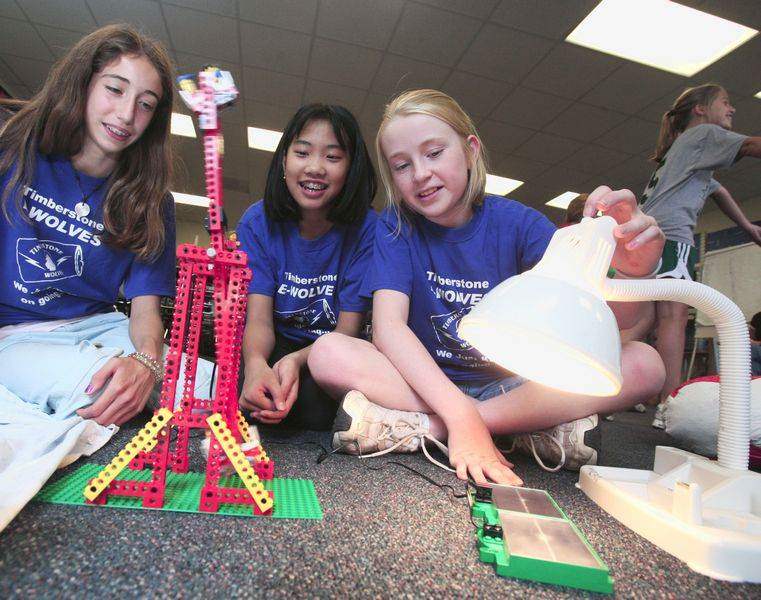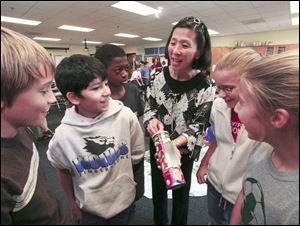
Bike and bulbs power ideas about energy conservation at Sylvania Timberstone
10/11/2007
Elizabeth Sares, Michelle Li, and Jordan Truitt, all 12, work on a solar-powered toy at Sylvania's Timberstone Junior High as part of an energy-conservation awareness project.

Timberstone Junior High science teacher Rini Ng shows a solar hot dog cooker to, from left, Luke Gayer, 11; Kal Aridi, 11; Damon Ide, 12; Reba Darrin, 11, and Madison Edwards, 11. The students are teaching each other the merits of energy conservation.
Hot dogs cooking inside potato crisp cans. Tiny cars zipping around the floor. Passengers bonking their heads on wild amusement rides.
What's going on here?
Plenty, says Rini Ng, sixth-grade science teacher at Sylvania's Timberstone Junior High School, where hands-on activities are sparking student interest in energy.
Leading the charge is the Timberstone E-Wolves, a team of seventh-grade students.

Elizabeth Sares, Michelle Li, and Jordan Truitt, all 12, work on a solar-powered toy at Sylvania's Timberstone Junior High as part of an energy-conservation awareness project.
Just outside Mrs. Ng's classroom, light bulbs flash on and off as students pedal a bicycle engineered and built by the E-Wolves as part of a school/community energy conservation awareness program.
The bicycle is wired to an electronic board to visually show people how much energy they must produce to light incandescent lights as opposed to fluorescent ones.
The E-Wolves last week presented the powerful demonstrations to students at Timberstone, and Mrs. Ng said the team will take the energy bike to the Sylvania Senior Center and the Sylvania school board in the coming weeks.
The bike-and-bulb lesson promotes energy conservation.
Here's why: it's a struggle to pedal the bicycle fast enough to turn on an incandescent light bulb, the standard bulb used by many homeowners. But it's a breeze to pump the pedals to turn on the fluorescent bulbs.
A participant who pedals mightily to produce enough energy to turn on an incandescent bulb tends to think twice about the energy needed to keep those kind of lights burning at home.
"Kids get it. They see how much energy it takes to turn on the lights," said Jillian Miksanek, an E-Wolves member. "Everyone is surprised by how much energy it takes."
If people pay attention and then take steps to conserve energy, it will help planet Earth, she said.
The E-Wolves' Elizabeth Sares said the energy project is particularly valuable because it involves "kids teaching kids," and Michelle Li said it "raises awareness about energy efficiency and things like that."
Students applied to be on the team, said 12-year-old Jordan Truitt, one of the E-Wolves. She wanted to be part of the project because she likes science.
Students in Mrs. Ng's classes are learning about other energy sources, too. They made solar-powered ovens to cook hot dogs, using wooden skewers inside foil-lined potato crisp cans.
At the back of the classroom, heat from a desk lamp (to simulate solar power) energized small-scale, student-built amusement park rides. Too much heat (much to the students' delight) propelled one ride at such a rapid rate that the plastic passengers bonked their heads as it looped around and around.
Students last week also made small solar-powered cars as part of the grant-supported energy project.
Funds from a $10,000 grant, awarded to Mrs. Ng last spring, was used to build the energy bike and another grant paid for energy-conservation kits for students. Kits include low-flow shower heads and energy-efficient light bulbs, the teacher said.
Sixth-grade student Zach Shuk-Stevens, 12, said students will use what they learn to help save the planet. "It shows us we should save energy and resources," he said.
A joint alternative energy project with the Timberstone students and the Olander Park System is being considered as well.
Alternative-energy forums recently hosted by Olander made "it clear that new forms of energy are not some future technology but already are working in many locations throughout the Sylvania region," said Gary Madrzykowski, park system director. Olander's new Sylvan Prairie Park is next door to Timberstone.
The students' innovative alternative energy experiments and projects match the park system's growing emphasis on green energy, he said.
With common agendas, it's "natural for the park system and the school district to explore ways we can work together to promote green solutions that educate and benefit the general public," he said.